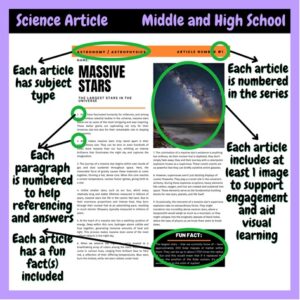By: Oliver Shearman
In the realm of education, particularly in science, there’s a growing emphasis on concise, impactful learning tools. Short format informative science articles that include comprehension and deep thinking questions within the text present an innovative approach to education. This method proves invaluable in classrooms, as homework, or as extension tasks. Let’s delve into how this integrated approach benefits student learning.
I am a big fan of these forms of activities, so much so that I have many different science articles available to fellow teachers to support them with their science classes – you can find the free ones here.

Short science articles with embedded questions ensure that students are not just passively reading but actively engaging with the material. These questions, designed to test comprehension, encourage students to think critically about what they’ve read, reinforcing their understanding and retention of scientific concepts.
By integrating comprehension and deep thinking questions, these articles transform reading from a passive to an active learning experience. This approach prompts students to constantly assess their understanding and apply critical thinking skills, fostering a more interactive and engaging learning process.
Such articles cater to students at different learning paces. Students who grasp concepts quickly can benefit from the deep thinking questions that challenge their understanding, while those who need more time can focus on basic comprehension questions. This flexibility makes it a versatile tool in diverse educational settings.
The deep thinking questions in these articles are not just about understanding the content but also about analyzing and applying it. This nurtures analytical skills, encouraging students to make connections with other concepts, think abstractly, and develop problem-solving skills.
Whether in a classroom, as homework, or as an extension task, these short format articles with questions are incredibly versatile. They can be used to introduce a new topic, reinforce previously taught material, or provide additional challenges for advanced learners.
Integrating short informative science articles with comprehension and deep thinking questions offers a multifaceted approach to education. It not only enhances understanding and retention of scientific concepts but also develops critical thinking and analytical skills. This approach is adaptable, engaging, and highly effective in fostering a deeper, more comprehensive understanding of science among students.
This format ensures that the key aspects of integrating comprehension and deep thinking questions within the science articles are highlighted, emphasizing their role in enhancing student learning.

